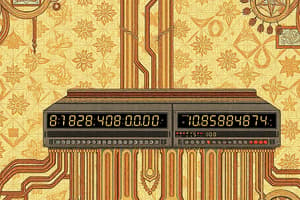Podcast
Questions and Answers
What type of counter changes state at the decreasing edge of every clock pulse?
What type of counter changes state at the decreasing edge of every clock pulse?
Which flip-flop changes state only when activated by the decreasing edge of the Q output of FFO?
Which flip-flop changes state only when activated by the decreasing edge of the Q output of FFO?
Why can't the flip-flops be activated concurrently in the given circuit?
Why can't the flip-flops be activated concurrently in the given circuit?
How many different states does a two-bit ripple counter have?
How many different states does a two-bit ripple counter have?
Signup and view all the answers
Which type of counter is connected to the clock input of the first flip-flop only?
Which type of counter is connected to the clock input of the first flip-flop only?
Signup and view all the answers
What is the mod number of a counter with n flip-flops?
What is the mod number of a counter with n flip-flops?
Signup and view all the answers
What is the characteristic of an asynchronous decade counter?
What is the characteristic of an asynchronous decade counter?
Signup and view all the answers
What is the modulus typically used for counters with shortened sequences?
What is the modulus typically used for counters with shortened sequences?
Signup and view all the answers
What is the purpose of partial decoding in a decade counter?
What is the purpose of partial decoding in a decade counter?
Signup and view all the answers
What happens when the UP input is at 1 and the DOWN input is at 0 in the three-bit up & down counter circuit?
What happens when the UP input is at 1 and the DOWN input is at 0 in the three-bit up & down counter circuit?
Signup and view all the answers
What causes an asynchronous up-down counter to be slower than an up or down counter?
What causes an asynchronous up-down counter to be slower than an up or down counter?
Signup and view all the answers
How are the CLK inputs of flip-flops connected in synchronous counters?
How are the CLK inputs of flip-flops connected in synchronous counters?
Signup and view all the answers
What is the max operating frequency of a synchronous counter relative to an equivalent ripple counter?
What is the max operating frequency of a synchronous counter relative to an equivalent ripple counter?
Signup and view all the answers
What is the major advantage of synchronous counters over equivalent ripple counters?
What is the major advantage of synchronous counters over equivalent ripple counters?
Signup and view all the answers
What does a synchronous decade counter do?
What does a synchronous decade counter do?
Signup and view all the answers
What does an asynchronous decade counter do?
What does an asynchronous decade counter do?
Signup and view all the answers
Study Notes
Counter Types
- A Down counter changes state at the decreasing edge of every clock pulse.
Flip-Flop Activation
- The second flip-flop changes state only when activated by the decreasing edge of the Q output of the first flip-flop (FFO).
Circuit Limitations
- Flip-flops cannot be activated concurrently in the given circuit.
Ripple Counter States
- A two-bit ripple counter has 2^2 = 4 different states.
Counter Connection
- A Synchronous counter is connected to the clock input of the first flip-flop only.
Counter Modulus
- The mod number of a counter with n flip-flops is 2^n.
Asynchronous Decade Counter
- An asynchronous decade counter has a characteristic of counting up or down in a sequence of 0-9 and then resetting to 0.
Modulus for Shortened Sequences
- The modulus typically used for counters with shortened sequences is 2^n.
Partial Decoding
- The purpose of partial decoding in a decade counter is to reduce the number of gates required to drive the display.
Three-Bit Up & Down Counter
- When the UP input is at 1 and the DOWN input is at 0 in the three-bit up & down counter circuit, it counts up.
Asynchronous Up-Down Counter
- An asynchronous up-down counter is slower than an up or down counter due to the additional delay caused by the asynchronous clocking.
Synchronous Counter CLK Inputs
- The CLK inputs of flip-flops are connected in parallel in synchronous counters.
Synchronous Counter Frequency
- The maximum operating frequency of a synchronous counter is higher than that of an equivalent ripple counter.
Synchronous Counter Advantage
- The major advantage of synchronous counters over equivalent ripple counters is their higher operating frequency.
Synchronous Decade Counter
- A synchronous decade counter counts from 0 to 9 and then resets to 0 upon reaching the maximum count.
Asynchronous Decade Counter
- An asynchronous decade counter counts up or down in a sequence of 0-9 and then resets to 0 upon reaching the maximum count.
Studying That Suits You
Use AI to generate personalized quizzes and flashcards to suit your learning preferences.
Description
Test your knowledge of different types of counters used in digital electronics, including asynchronous counters, synchronous counters, decade counters, and up-down counters.




